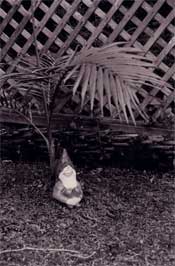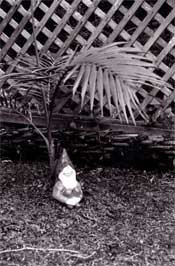Color Tone
The lightness and darkness of a color basically describes Tone.
The tone is affected by two parts – the value, the amount of black or white it contains and the intensity/saturation, the amount of color it contains. The combination of these produces tone.
The ability to understand tone will be the difference between a dull and boring scheme and a great well-balanced pleasing scheme.

Picture– This black and white photograph is very boring as the tone is very flat. Through half closed eyes we only see the gnomes beard and the rest is the background – a large gray mass.

Picture – Half close your eyes and look at the same photograph that has been digitally altered. You will now see the lattice fence in the background, a palm in the mid ground and the grass of the foreground. There are definite changes in tone to be seen.

Picture – Half close your eyes and view the changes in tone more sharply.
Tone can be used to alter proportions of a room like color. The deeper the tone of color the less light can be reflected from it and this causes the color to appear closer than it really is. The lighter the tone the more light reflection and the color will appear further away.
When using a monochromatic scheme, it is essential to vary the tones of the color or the scheme will appear boring and uninteresting, as there is no sense of depth or balance.
The best way to view tone is the same way as an artist, through half closed eyes. By doing this you can view the tonal range. Looking at black and white photographs is another way to learn.
Find More Knowledge on Color
Popular Color Schemes
Free Color Course
Color Articles
Color Information
Color Meanings
Color Schemes
Color Theory
Paint
